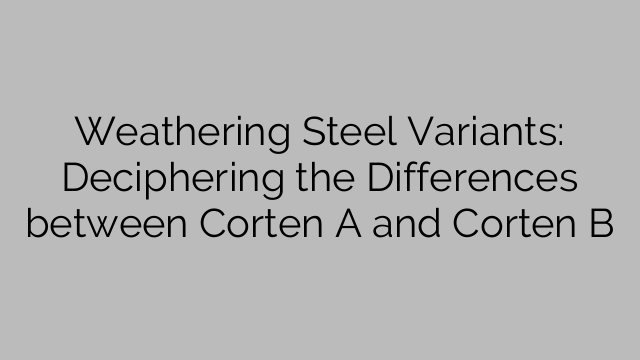Within the world of weathering steel, there are two primary variants known as Corten A and Corten B. While they share many similarities, there are a few important distinctions to be aware of. In this article, we will delve into the differences between these two variants to help you decipher which may be more suitable for your specific application.
化学組成:
Corten A and Corten B have slightly different chemical compositions. Corten A primarily consists of iron with small amounts of copper, chromium, nickel, and phosphorus. On the other hand, Corten B contains iron, chromium, copper, and phosphorus with limited amounts of nickel. The differences in composition result in subtle variations in their mechanical properties and corrosion resistance.
機械的性質:
Both Corten A and Corten B possess similar mechanical properties. They have high tensile strength and yield strength, which makes them suitable for structural applications where strength is crucial. However, Corten B exhibits slightly better toughness and impact resistance compared to Corten A, making it a preferred choice for load-bearing structures.
Corrosion Resistance:
The main distinguishing factor between Corten A and Corten B lies in their corrosion resistance. Corten A has excellent resistance to atmospheric corrosion due to the formation of a tightly adhering protective oxide layer on the steel’s surface. This layer not only prevents further corrosion but also provides an aesthetic appeal with its characteristic rust color. Corten B, on the other hand, exhibits enhanced resistance to corrosion in comparison. This makes Corten B more suitable for applications that require prolonged exposure to harsh weather conditions or highly corrosive environments.
Availability and Cost:
As both Corten A and Corten B fall under the weathering steel category, they are readily available in the market. However, Corten A is more commonly used and easily accessible compared to Corten B. Due to its enhanced corrosion resistance, Corten B is often slightly more expensive than Corten A. However, the price difference may vary depending on factors such as location and availability.
Application:
Both Corten A and Corten B find application in a wide range of industries and structural elements. They are commonly used in outdoor sculptures, architectural facades, bridges, shipping containers, and even chimney liners. While Corten A is often preferred for its aesthetic appeal, Corten B is chosen when superior corrosion resistance is required.
In conclusion, Corten A and Corten B are two variants of weathering steel that offer unique properties suitable for various applications. While Corten A is known for its aesthetic appeal and excellent resistance to atmospheric corrosion, Corten B offers enhanced corrosion resistance, toughness, and impact resistance. Making the right choice between these variants will depend on the specific requirements of your project, considering factors such as location, exposure to elements, and desired longevity.
[ad_2]

